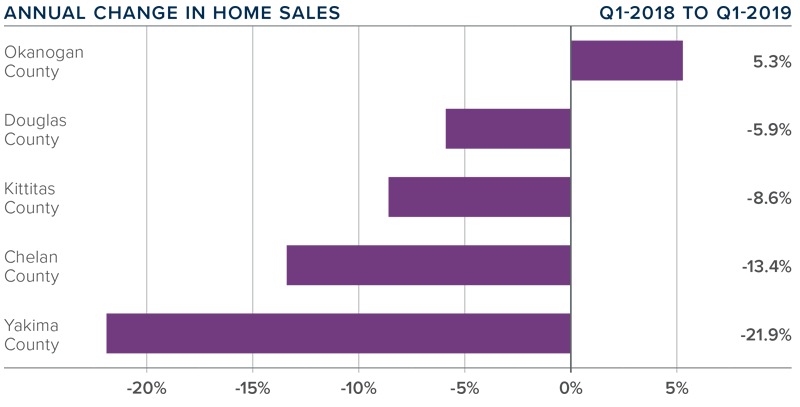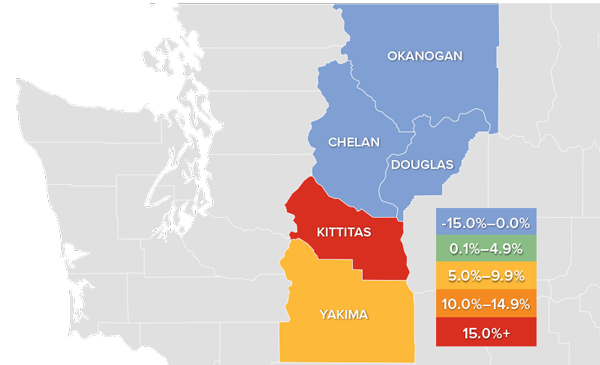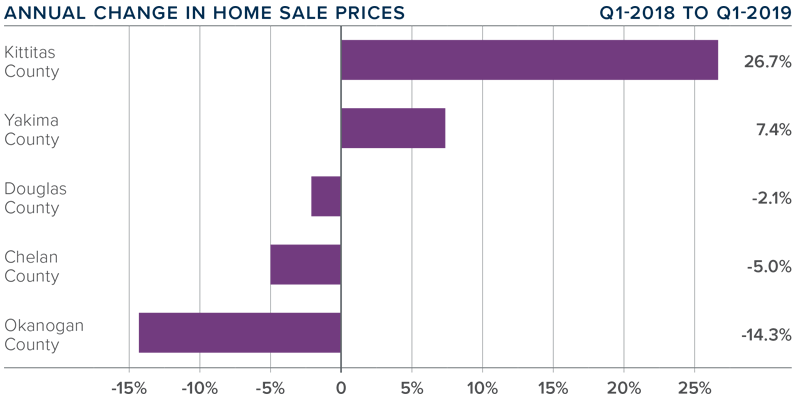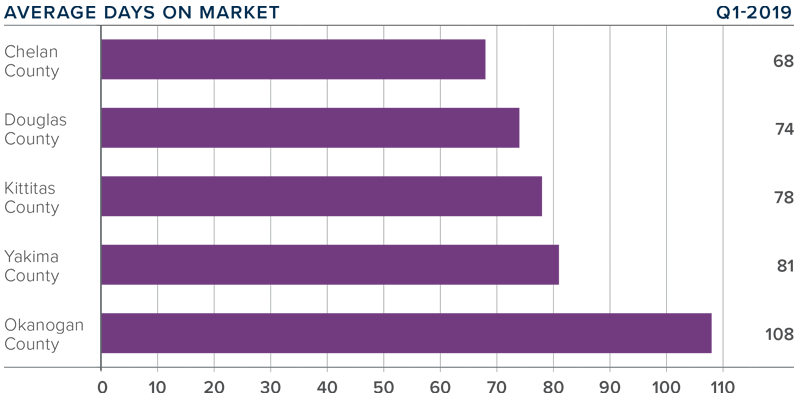The following analysis of the Central Washington real estate market is provided by Windermere Real Estate Chief Economist Matthew Gardner. We hope that this information may assist you with making better-informed real estate decisions. For further information about the housing market in your area, please don’t hesitate to contact your Windermere agent.
ECONOMIC OVERVIEW
Washington State employment slowed to an annual growth rate of 1.7% — a level not seen since 2012 — and continues a trend of slowing that started in the summer of 2018. Over the past 12 months, the state added 56,100 new jobs. Month-over-month, all metropolitan areas in the state either saw the number of jobs contract or remain at their existing levels. This is a little unusual and may be due to the state re-benchmarking their data. As such, I am not overly concerned about the numbers but will be watching to see if this trend continues as we move through the spring months.
The state unemployment rate was 4.5%, marginally below the 4.6% level a year ago. On a seasonally adjusted basis, the counties within Central Washington added 6,439 new jobs over the past 12 months, representing a solid growth rate of 2.8%. The local unemployment rate rose when compared to a year ago, from 6% to 6.7%, but this is a result of increases in the labor force.
HOME SALES
- In the first quarter of 2019, home sales throughout Central Washington fell by 13.7%, with a total of 755 homes sold, and were 44.6% lower than the fourth quarter of 2018.
- Sales rose in Okanogan County, which saw an increase of 5.3% over the first quarter of 2018. Yakima and Chelan counties saw sales activity slow the most.
- The number of pending home sales — an indicator of future closings — was down 22% compared to the fourth quarter, indicating that closings will likely drop further in the second quarter of 2019.
- Listing activity was a mixed bag when compared to a year ago, with significant increases in Kittitas and Chelan counties but declines in the balance of the region. That said, I expect stronger sales as we move through the spring because the drop in interest rates will get buyers off the fence.

HOME PRICES
 Year-over-year, the average home price in the region rose 6.4% to $310,386. Price growth has been trending well above the long-term average, but the data suggests we are starting to see some softening in the market. It is likely that price growth will continue to cool — but not turn negative — as we move through 2019.
Year-over-year, the average home price in the region rose 6.4% to $310,386. Price growth has been trending well above the long-term average, but the data suggests we are starting to see some softening in the market. It is likely that price growth will continue to cool — but not turn negative — as we move through 2019.- Although prices declined in Okanogan, Chelan, and Douglas counties, I am not particularly worried as these are all relatively small markets where prices can see major swings.
- Prices rose in Kittitas and Yakima counties but fell in the rest of the region compared to the first quarter of 2018. Regionwide, home prices were down 6.5% compared to the final quarter of 2018.
- In aggregate, home-price growth has slowed, but the winter months can be inconsistent. I would not be surprised to see a jump in prices in the second quarter as the weather improves and interest rates remain low.

DAYS ON MARKET
- The average number of days it took to sell a home in Central Washington rose three days compared to the first quarter of 2018.
- The average time it took to sell a home in the region was 82 days, up 11 days when compared to the fourth quarter of 2018.
- Two markets contained in this report — Okanogan and Yakima — saw days-on-market drop from the same quarter in 2018. The balance of the region took slightly longer to sell a home.
- Homes sold fastest in Chelan County, where it took an average of 68 days to sell a home. The greatest drop in the time it took to sell a home was in Yakima County, where it took 13 fewer days than in the first quarter of 2018.

CONCLUSIONS
 This speedometer reflects the state of the region’s real estate market using housing inventory, price gains, home sales, interest rates, and larger economic factors.
This speedometer reflects the state of the region’s real estate market using housing inventory, price gains, home sales, interest rates, and larger economic factors.
For the first quarter of 2018, I have moved the needle a little more in favor of buyers. Inventory levels remain low, but I anticipate this will change. This, in concert with moderating price growth and very favorable interest rates, will continue to favor home buyers in the coming months.
 As Chief Economist for Windermere Real Estate, Matthew Gardner is responsible for analyzing and interpreting economic data and its impact on the real estate market on both a local and national level. Matthew has over 30 years of professional experience both in the U.S. and U.K.
As Chief Economist for Windermere Real Estate, Matthew Gardner is responsible for analyzing and interpreting economic data and its impact on the real estate market on both a local and national level. Matthew has over 30 years of professional experience both in the U.S. and U.K.
In addition to his day-to-day responsibilities, Matthew sits on the Washington State Governors Council of Economic Advisors; chairs the Board of Trustees at the Washington Center for Real Estate Research at the University of Washington; and is an Advisory Board Member at the Runstad Center for Real Estate Studies at the University of Washington where he also lectures in real estate economics.
 Facebook
Facebook
 X
X
 Pinterest
Pinterest
 Copy Link
Copy Link



